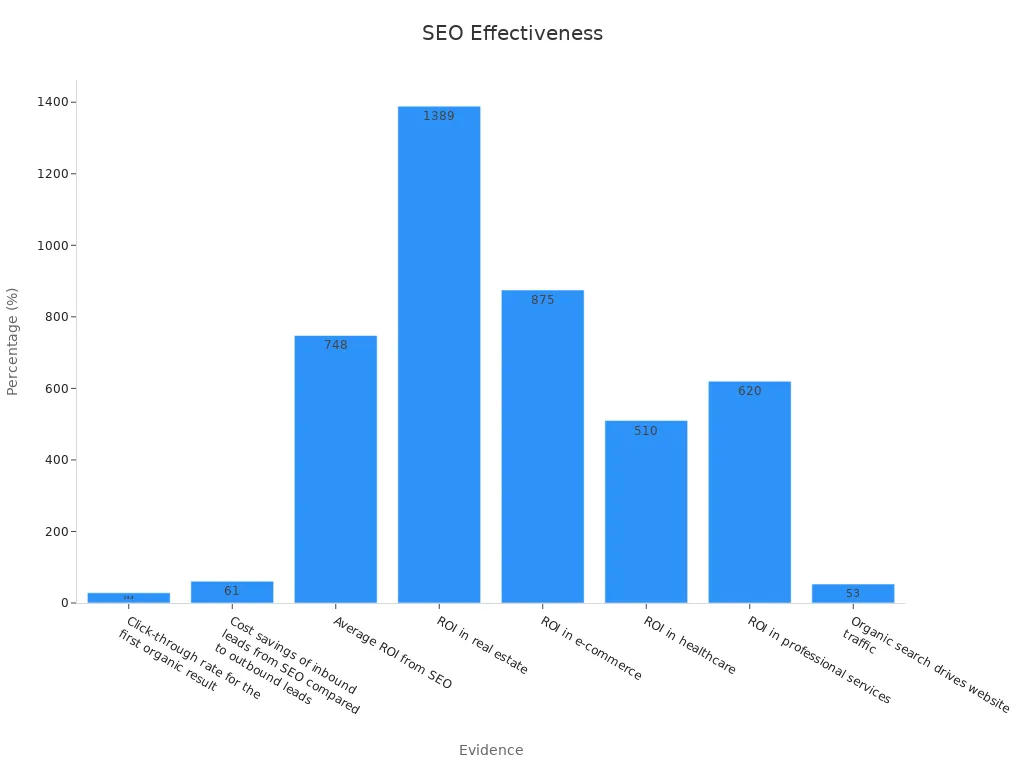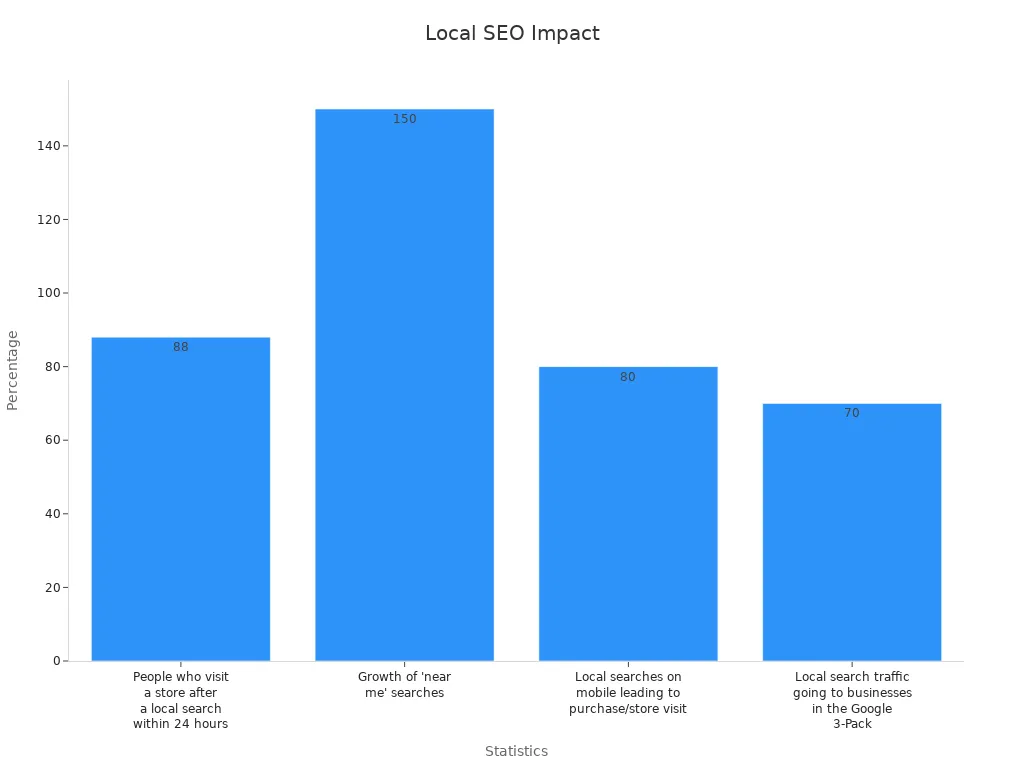What Is SEO and How Does It Work in 2025

Search Engine Optimization (SEO), or what is SEO, means making your website easier to find. It helps your site show up higher on Google searches, bringing more visitors to your website without paying for ads. In 2025, understanding what is SEO is very important for online success. Over half of website visits come from search engines, so SEO is a must.
To stay ahead, you need to follow new trends and tools. Mobile-first indexing and voice search are now very popular. What is SEO has evolved to focus more on users. It’s not just about using keywords anymore; it’s about knowing what people want and providing them with helpful content.
Key Takeaways
SEO helps websites get noticed and brings free visitors. For every $1 spent on SEO, businesses can earn up to $22.
Making good content and being honest builds trust. Trusted websites show up higher in search results, bringing more visitors.
Keeping up with trends like mobile-first indexing and voice search is important. Changing content to fit what users want helps rankings and makes users happy.
Checking and updating your SEO plan often is needed. Use tools to see how you're doing and change things based on user actions and search engine updates.
AI tools make SEO work easier. Tools like QuickCreator help make good content fast, saving time and meeting search engine rules.
Why Does SEO Matter in 2025?
Bringing in free traffic and boosting visibility
SEO is still great for getting free visitors to your site. In 2025, companies posting blogs often get 55% more visitors. They also have 434% more pages noticed by search engines, making them easier to find. Free search now makes up 17% of all website visits, so it’s a key way to reach people.
When you match your content with what people search for, you show up in results more often. This not only brings more visitors but also helps them find useful info on your site. For every $1 spent on SEO, businesses make $22 back, showing how valuable it is.

Building trust and a strong brand
SEO isn’t just about visitors; it helps people trust you. Good content, honesty, and being an expert make your site reliable. Adding SSL certificates and detailed author info can make your site safer and more believable. Being active on social media and using clear data also helps build trust.
Trust affects how search engines rank your site. Trusted sites rank higher and get more free traffic. By sharing facts and expert advice, you can become a trusted source and keep your audience coming back.
Keeping up with changing search engines and user needs
Search engines in 2025 focus on what users want and need. Businesses must change their plans to meet these new rules. For example, 58.5% of searches now give answers right on the search page. To stay ahead, you should aim for featured snippets and clear data.
Most searches happen on phones, with AI tools playing a big role. Making content that gives quick, helpful answers keeps your site important. By learning these trends, you can make sure your SEO fits what users and search engines expect.
How Does SEO Work?
How search engines rank websites
Search engines decide which websites show up first. They check how well your content matches what people search for. They also look at how important your page is by checking links. For example, PageRank checks how many links point to your page. These systems help users find useful and trusted information.
Model Type | What It Does |
|---|---|
Sorts pages based on how well they match search terms. Examples: Boolean model, Vector Space Model (VSM). | |
Importance Ranking Models | Checks how valuable a page is by looking at links. |
Evaluation Methods | Tests how well ranking systems work using experiments like Cranfield. |
Search engines also watch how people use your site. They see how long visitors stay or how many links they click. This helps improve search results.
Steps to improve your website with SEO
SEO has steps to make your site easier to find. First, find out what words people search for. Use tools like Google Keyword Planner to pick popular words. Then, plan your content around these words. Make fun articles, videos, or pictures that answer questions.
After creating content, add it to your site. Make sure titles, descriptions, and images are easy for search engines to read. Once it’s live, check how it’s doing. Look at things like how many people visit, how long they stay, and if they click links.
Metric | What It Means |
|---|---|
Shows how many visitors take action, like buying something. | |
Time on page | Tells how long people stay on a page, showing interest. |
Pages per visit | Counts how many pages a visitor looks at, showing engagement. |
Bounce rate | Tracks when visitors leave without clicking anything else, showing if they found what they need. |
Search traffic | Measures how many people find your site through search engines. |
Why you need to keep checking and changing your SEO
SEO doesn’t end after posting content. You must check how your site is doing and make changes. Search engines often update their rules. Use tools like Google Analytics to see how updates affect your site. If visits drop, change your plan to fix it.
Look at search engine results often to stay ahead. See what content ranks high and what people want. Changing quickly helps your site stay important and easy to find.

Tip: Watch numbers like click-through rate and domain authority. These help you see how well your site is doing and what to improve.
Types of SEO and Their Roles
On-page SEO: Making content better and using keywords
On-page SEO improves each page's content and layout. It helps your pages match what people search for and follow search engine rules. Fixing titles, headings, and descriptions makes your content easier to find. Smartly placing keywords in your writing helps search engines know your page's topic.
Metrics like Core Web Vitals are important for checking on-page SEO. These include Largest Contentful Paint (LCP), which shows how fast main content loads, and Cumulative Layout Shift (CLS), which tracks sudden layout changes. Watching keyword rankings and organic traffic shows how well your content works. For example, more clicks mean good keyword use and interesting content.
Metric | What It Measures |
|---|---|
Core Web Vitals | Checks page load speed and user experience. |
Keyword Rankings | Tracks how well your keywords rank in searches. |
Organic Traffic Analysis | Shows how many visitors come from search engines. |
Off-page SEO: Getting backlinks and building trust
Off-page SEO works outside your site to make it stronger. Getting backlinks from trusted websites is a top strategy. Search engines see backlinks as votes of trust, especially from sites with high authority. Good backlinks can improve your rankings a lot.
Off-page SEO also includes sharing your content on social media and talking with your audience. These actions build trust and encourage others to share your work. Websites with strong backlinks often rank higher, making off-page SEO very important for success.
Tip: Get backlinks from trusted websites. This boosts rankings and makes your site more reliable.
Technical SEO: Making your site faster and easier to use
Technical SEO makes sure your site runs well and meets search engine needs. It focuses on speed, mobile use, and how search engines read your site. Slow pages can lose visitors, so Google suggests loading in under three seconds.
Mobile-friendly sites are key since most searches happen on phones. Google’s mobile-first indexing favors mobile-ready sites in results. Technical SEO also improves crawlability and indexability, helping search engines understand your content. A well-organized site gives users a better experience, keeping them engaged longer.
Metric | What It Measures |
|---|---|
Shows how fast your pages load, affecting rankings and user experience. | |
Mobile-Friendliness | Checks if your site works well on phones, helping search visibility. |
Crawlability | Measures how easily search engines can explore your site. |
Indexability | Ensures search engines understand your content for better results. |
Note: Test your site’s speed and mobile setup often to stay ahead.
Local SEO: Reaching nearby customers through searches.
Local SEO helps people find your business in their area. It makes your business show up when locals search for products or services. In 2025, this is very important as more people use phones and voice search to find nearby businesses.
If someone searches "pizza place near me," they want fast, accurate results. Local SEO helps your business appear in these searches. Tools like Google My Business (GMB) show your location, hours, and reviews. A well-optimized GMB profile can get your business into the Google 3-Pack, which gets most local search traffic.
Statistic | Value |
|---|---|
People visiting a store after a local search within 24 hours | 88% |
Growth of 'near me' searches | 150% |
Local searches on mobile leading to purchase/store visit | 80% |
Local search traffic going to businesses in the Google 3-Pack | 70% |
Geographic data is key for local SEO. It helps you focus on specific areas and groups. For example, 88% of people visit a store within a day of searching locally. This shows why location-based keywords are important. Also, "near me" searches have grown by 150%, proving the need for local SEO.

Reviews also matter for local SEO. About 93% of people trust reviews when choosing where to shop. Ask happy customers to leave reviews to improve your rankings. Make sure your website works well on phones since most local searches happen there.
By using local SEO, you can bring in nearby customers, increase visits, and grow your business. It’s a great way to stay ahead in your community.
The Evolution of SEO and Trends in 2025

How AI and machine learning change search engines
AI and machine learning have changed how websites rank. Google now understands the meaning behind searches better. Old tricks like stuffing keywords no longer work. Search engines now care about helpful answers and meaningful content.
For example, tools like BERT and MUM help Google understand words in context. These tools make sure your content matches what users really want. AI also adjusts search results based on user habits. If your content fits their needs, it ranks higher.
AI-powered assistants are also changing searches. People now get direct answers instead of clicking links. To stay visible, your content must be clear, short, and accurate.
Why user experience and search intent matter more
User experience (UX) and search intent are now key for SEO. Search engines reward sites that meet user needs. If your content isn’t helpful, it won’t rank well. By knowing what users want, you can create content they enjoy.
Focusing on user intent makes your site better. For example, if someone searches "what is SEO," they want a simple answer. Giving clear info helps your rankings and builds trust. Meeting user needs keeps them on your site longer.
New trends like voice search and mobile-first indexing
Voice search and mobile-first indexing are shaping SEO’s future. By 2024, over half of U.S. homes will have smart speakers. Voice searches often ask for local info, so using location-based keywords helps attract nearby users.
More people now use phones than computers. Google checks your site’s mobile version first. If your site isn’t mobile-friendly, your rankings may drop. Fast loading and responsive designs keep your site competitive.
Trend/Statistic | Value/Insight |
|---|---|
Blogs in first-page results | |
Increase in long queries since 2013 | 322% |
Mobile-first indexing is now the standard | |
Voice search adoption | 55% of U.S. households own smart speakers |
By following these trends, your site stays useful and easy to find.
Generative Engine Optimization vs. Traditional SEO
What is Generative Engine Optimization?
Generative Engine Optimization (GEO) helps content work well with AI searches. Unlike traditional SEO, which focuses on keywords, GEO creates detailed and helpful content. It matches what users want and answers tough questions clearly.
GEO works with AI tools like ChatGPT and Perplexity AI. These tools give quick, clear answers, making them popular. ChatGPT has over 180.5 million users each month. Perplexity AI’s searches grew by 858% last year. Using GEO can make your content easier to find and improve user experience. This keeps your site strong in a changing online world.
How AI-generated content is transforming SEO practices
AI-made content is changing SEO by making it faster and better. It helps create content that ranks high, brings visitors, and keeps them interested. Important metrics show its value.
Metric | Description |
|---|---|
Shows how well AI-made content ranks for keywords. | |
Traffic Generation | Tracks visitors, sessions, and page views from the content. |
User Engagement | Measures how long visitors stay and actions they take. |
AI tools study search trends and user habits to make useful content. This keeps your content helpful and boosts its ranking chances. Using AI saves time and effort while making content your audience likes.
Comparing the benefits and challenges of Generative Engine Optimization and traditional SEO
GEO and traditional SEO both have good points. GEO is great for keeping up with AI searches and meeting user needs. It focuses on context and intent, making users happy. Traditional SEO works well for regular search engines and long-term plans.
But GEO has challenges. You need to follow AI updates and adapt fast. Traditional SEO may not keep up with fast-changing AI platforms. By using both GEO and traditional SEO, you can make a strong plan that uses the best of both.
Tip: Use GEO for AI platforms and traditional SEO for regular searches. This mix helps your content reach more people effectively.
Ranch Style SEO: A Lasting and User-Friendly Approach
What is Ranch style SEO?
Ranch style SEO means making plans that last and help users. Instead of quick fixes, you create strong, useful content for people. This method focuses on being helpful, unique, and keeping users happy.
It creates content that matches what users are looking for.
It focuses on topics, not just single keywords, for better results.
It values original, good-quality content to improve user experience.
Using Ranch style SEO helps your site grow with your audience and search engine changes.
Making a long-lasting, user-first SEO plan
A user-first SEO plan keeps your content helpful for a long time. You learn what your audience wants and give it to them often. This builds trust and makes your site an expert in its field.
What It Means | |
|---|---|
Steady Traffic Growth | Your content brings regular visitors, keeping your site visible and active. |
Building Authority | Covering topics well shows expertise, helping your site rank higher. |
Better User Engagement | Great content keeps users interested and makes them return for more. |
By focusing on these goals, you attract visitors and make them want to stay.
How Ranch style SEO fits with today’s search engines
Search engines now like content that is helpful and shows expertise. Ranch style SEO works well with this by focusing on topics instead of just keywords. This way, your content answers what users really need.
Ranch style SEO fights the bad effects of AI by focusing on unique ideas.
Google now ranks sites higher for original content, as seen in its 2024 updates.
Using Ranch style SEO helps you keep up with search engine changes and build a strong, user-friendly website.
Tools and Techniques for Effective SEO in 2025

How AI tools like QuickCreator AI Blog Writer help with SEO
AI tools, like QuickCreator AI Blog Writer, make SEO easier in 2025. These tools help create content that follows search engine rules. QuickCreator adds good backlinks to blogs, making them more trustworthy. It also meets Google’s E-E-A-T (Experience, Expertise, Authoritativeness, and Trustworthiness) standards, helping your content rank better.
Using AI tools can grow your website traffic a lot. For instance, QuickCreator users have seen traffic grow by over 10 times. These tools handle keyword research and organize content, saving you time. They also study trends and user habits to match what people are searching for.
Feature | What It Does |
|---|---|
Backlink Integration | Adds trusted backlinks to improve blog reliability. |
E-E-A-T Standards | Ensures content meets Google’s quality and trust guidelines. |
Traffic Growth | Helps increase organic traffic by over 10 times. |
Tips for making SEO-friendly content
To make SEO-friendly content, focus on what your audience needs. Use tools like Google Keyword Planner to find popular search terms. Then, write content that answers questions or solves problems. Good content ranks higher and keeps readers interested.
Check how your content is doing by looking at metrics like organic traffic and click-through rates (CTR). Organic search brings more visitors than ads, with a CTR of 27.6% compared to 3.17% for ads. Pages ranked first get 81.5% more clicks than those in second place. Also, fast-loading pages improve user experience since a 1-second delay can lower conversions by 20%.
Statistic | What It Shows |
|---|---|
Organic Search Traffic | Brings more visitors than other marketing methods. |
Click-Through Rates | Organic search has a much higher CTR than paid ads. |
Page Speed | Slow pages can lose up to 20% of potential conversions. |
Using analytics to track and improve SEO
Analytics tools are key for improving SEO. Google Analytics helps you see how users behave on your site. Use the Landing Pages Report to find pages with lots of views but few clicks. Fix these pages to get more clicks and keep users engaged.
Search Console Integration lets you check keywords and update content to match what users want. Behavior Flow reports show where users leave your site, so you can improve those areas. By checking these metrics often, you can adjust your plan and keep your SEO strong.
Tip: Watch metrics like bounce rate, time spent on pages, and conversions to see how well your SEO is working.
SEO in 2025 is key to online success. It helps your site stay visible, trusted, and meet user needs. Important areas like E-E-A-T, zero-click searches, and mobile-first indexing show the need for user-focused strategies. The table below explains these priorities:
Key Focus Areas | What It Means |
|---|---|
E-E-A-T | Focuses on trusted, expert-checked content for important topics. |
Zero-click Searches | 60% of searches get no clicks, so new strategies are needed. |
Core Web Vitals | Improves things like page load speed and layout stability. |
Mobile-first Indexing | Gives better rankings to mobile-friendly websites. |
Semantic SEO | Matches content with new search tools for better results. |
To succeed, you need to keep learning and adapting. Follow updates, join webinars, and learn from experts. Websites like Moz and Search Engine Journal share helpful tips to improve your SEO.
QuickCreator makes this easier by offering tools to create SEO-friendly content quickly. Its AI features help meet search engine rules, saving time and improving your site. Using tools like this keeps you ahead in the changing world of SEO.
FAQ
What matters most for SEO in 2025?
Search engines care about user experience. Pages should load fast and work well on phones. Content must be helpful and original. Focus on what users need. Tools like QuickCreator can make your site better for these things.
How does AI change SEO plans?
AI helps search engines understand what users want. It likes content that answers questions clearly. Make detailed content that focuses on users. AI tools like QuickCreator can help create blogs that match these needs.
Can small businesses use SEO?
Yes! SEO helps small businesses get noticed online. Local SEO is great for reaching nearby customers. Update your Google My Business profile and use local keywords to rank higher.
How often should SEO plans change?
Check your SEO plan often. Search engines change their rules a lot. Use tools to see how your site is doing. Update your content to match new trends. This keeps your site competitive.
What tools help with SEO in 2025?
AI tools like QuickCreator make SEO easier. They help with finding keywords, writing content, and adding backlinks. These tools save time and improve your site, keeping you ahead online.
Tip: Watch your site's stats often. This helps you find ways to improve and keep your SEO strong.
See Also
Navigating SEO's Future Amid Google's Generative Search Innovations
Understanding SEO: A Detailed Guide to Search Optimization
Examining Google's SGE: Future Impacts on SEO Strategies
SEO in 2024: Adapting to AI, Disruptions, and Content Trends

